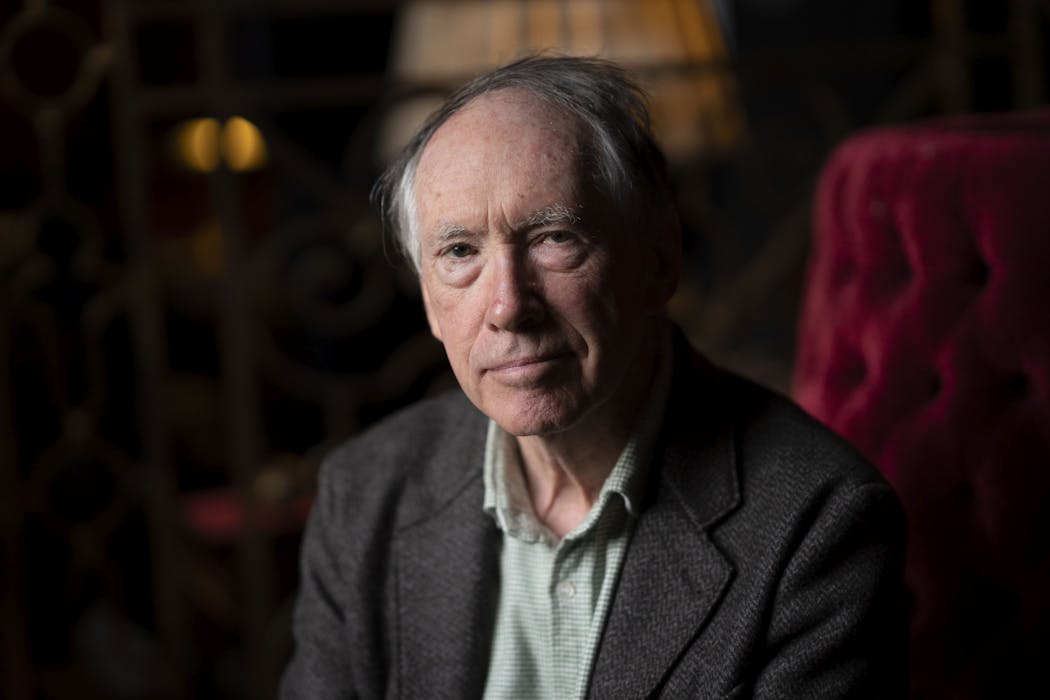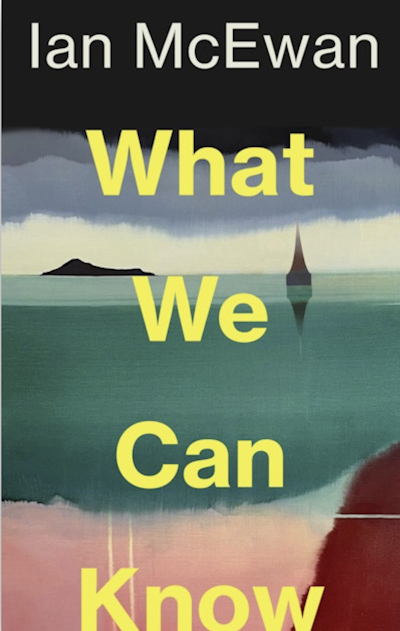
Ian McEwan’s new novel, his 18th in a long career of writing books that play with startling premises, bold ideas and big dilemmas, begins as a work of futurist fiction set in 2119. It’s a time when the climate catastrophe has delivered devastating floods to the world and nuclear conflicts have upended world powers.
What We Can Know – Ian McEwan (Penguin Random House)
The United States is a country of heavily armed warlords. Britain is a series of islands with severely limited populations and the centre of world power has shifted to Africa. AI has not, after all, transformed the way the world works because it more or less came to a halt before it got going, thanks to the collapse of populations, the flooding and the wars.
The steady and dour Tom Metcalfe narrates the first half-and-a-bit of the novel. He is an English literature academic (the humanities are still in crisis) and the period he has spent his life researching and teaching is 1990 to 2030. This is possibly one of the dullest literary periods a scholar could choose to devote his life to and one his students increasingly refuse to spend their time on.
Metcalfe is in pursuit of a poem that has disappeared. The poet who wrote it was Francis Blundy – after Seamus Heaney, the most famous poet of this period – and one whose fame reached unimaginable heights when one of his love poems to his wife featured in a Hollywood movie. All drafts of this poem were destroyed by Blundy. Only one copy ever existed, a gift to his wife. The fate of that one copy is unknown in 2119.
Metcalfe spends a lot of time reading the diaries of the poet’s wife, Vivien Blundy, and has confessed to his own lover he is more than half in love with Vivien. He fantasises sometimes that he might have become her husband if he had lived in the period of his research, which he does more or less. It was a time, he keeps reminding us, when food tasted as it should have, when there were still forests you could stroll through, even if species extinctions were already rampant.
The elusive poem might be a masterpiece, one of the most lyrical, insightful and powerful incursions by poetry into the crises of nature ever produced by an English poet. The poem has become famous, especially as an emblem of the Greens protest movement in Britain. This, despite the common knowledge that Bundy was a bullying, climate-change denier.
Searching diligently for this poem, Metcalfe reads and rereads Vivien’s journals – in actual archives and in the digital archive of emails sent. He scours Bundy’s emails, his publisher’s and those of his friends.
It is a little odd that only emails are mentioned as the content of the planet’s digital archive when social media already has exploded far beyond the almost quaint mode of communication known as emailing. In any case we get a good sense of the grind that literary scholarship requires.
But Metcalfe also has a novelist’s impulse in him and he doesn’t mind departing from strict scholarship to recreate the period he is researching.
A poetry reading
Metcalfe recreates for us the second Immortal Dinner. The first Immortal Dinner took place in 1817 at the London home of a well-connected but obscure painter, Benjamin Haydon. The poets Keats and Wordsworth and Shakespeare scholar Charles Lamb were in attendance, among some others. Accounts of the night mention wild drinking, witty and smutty talk, much laughter, and insults taken and forgiven. It became famous in the telling, though it might have been a blur for most of those who were there.
The second (fictional) Immortal Dinner takes place at the Bundy’s country home in October 2014. Friends, family and colleagues gather for the birthday of Vivien and the first reading of a new, major poem written over many months by Blundy especially for his wife.

It was written on vellum in the form of a Corona, 15 interlinked sonnets. The account of Blundy reading his poem to the mostly drunk or half drunk gathering at the party is one of the most entertaining episodes in the novel. If we give Blundy just over a minute and a half to read each sonnet, he keeps them listening for about 25 minutes, not counting the ex tempore, ten-minute introduction by his editor-biographer.
McEwan takes us through the distracted, resentful, self-loathing, meandering, bewildered, contemptuous and competitive thoughts of each person as Blundy recites his dense and clearly impressive achievement. Not one of those present can make coherent sense of the poem, just as, we suspect, most people at most poetry readings make little sense of what is declaimed in front of them.
This scene is a marvellous tour de force, and convinces us Metcalfe would make a much more interesting novelist than scholar. What we can know is often much duller than what we can imagine.
The novel begins to sprawl and the plot drifts as the reader is taken through the trials of teaching undergraduates, a rereading of Vivien’s journals about her first marriage to a violin-maker who descended into early dementia, Metcalfe’s dull devotion to dusty archives, his PhD studies, his lover’s infidelity and the possible fate of that famous poem. He knows Vivien so well that he is sure she has preserved it somehow.
When the search for the poem reaches its surprising, physically challenging climax on an unpopulated island halfway through the novel, the reader becomes increasingly afraid that they might actually be subjected to having to read the damn poem and make something of it.
A swerve
However, like Patricia Lockwood’s No One is Talking About This, or Yael van der Wouden’s The Safekeep, this novel takes a swerve into territory that’s deeply connected to the first half but wholly unexpected in tone, in emphasis, in feeling and in content.
Vivien takes charge of the second half of the novel, demonstrating that sometimes it is too painful, too shaming, and too dangerous to let anyone know what can be known.
I would be doing the novel a disservice to outline the way its first half is served back up to the reader in this second half, but it is worth saying that it makes the first part of the novel worth returning to for the many ways scholarship and imagination can fail to come anywhere near to knowing what might have happened in past lives.
Perhaps one of the most unexpected elements of this second part of the novel is the long and distressing dissection of decline-by-dementia from the point of view of a carer.
If there is a spirit of reformist Dickens in this subplot, it is a call from an ageing and terrified generation that some way must be found to provide support for a coming tsunami of dementia sufferers and their partners.
While the first half of the novel is a sly account of the resentment of the literary scholar towards the “genius” they must spend a life reading and researching, the second part enacts a shocking and severe set of vengeances upon patriarchal models of genius, upon hierarchies of art, upon the crime of dishonesty and upon those for whom sexual love is the only and most important love.
This futuristic novel with its sights set firmly on the present might, in some future scholar’s overview, take its place among those chronicling a world in crisis just as that world reached a series of unprecedented tipping points.
This article is republished from The Conversation, a nonprofit, independent news organization bringing you facts and trustworthy analysis to help you make sense of our complex world. It was written by: Kevin John Brophy, The University of Melbourne
Read more:
- Kamala Harris’ candid memoir reveals her ‘ideal’ vice president – and why she thinks she lost
- A.D. Hope called a Patrick White novel ‘verbal sludge’. New books celebrate these literary rivals
- Greg Sheridan thinks the early Christians have lessons for today’s faithful – is he right?
Kevin John Brophy does not work for, consult, own shares in or receive funding from any company or organisation that would benefit from this article, and has disclosed no relevant affiliations beyond their academic appointment.


 The Conversation
The Conversation
 Joplin Globe
Joplin Globe The Daily Beast
The Daily Beast Nola Entertainment
Nola Entertainment Glam
Glam